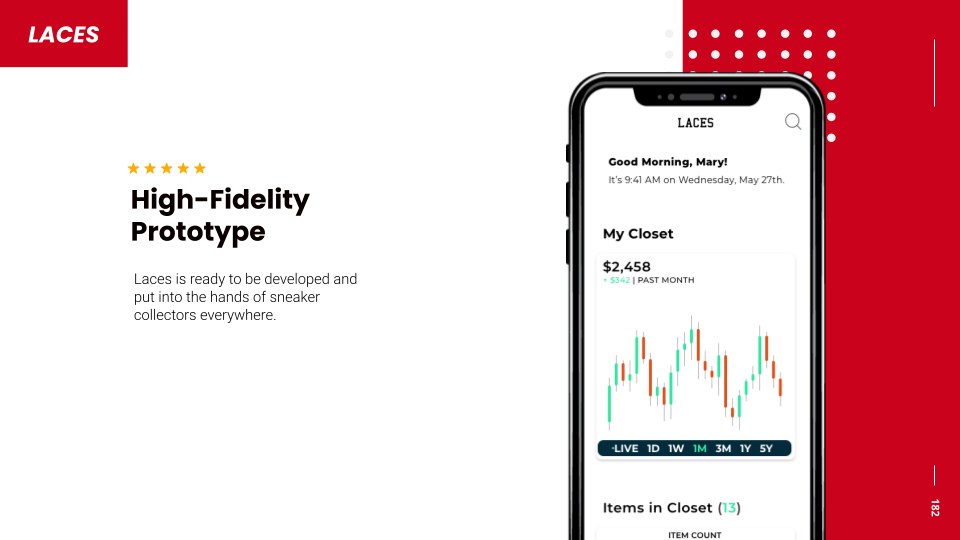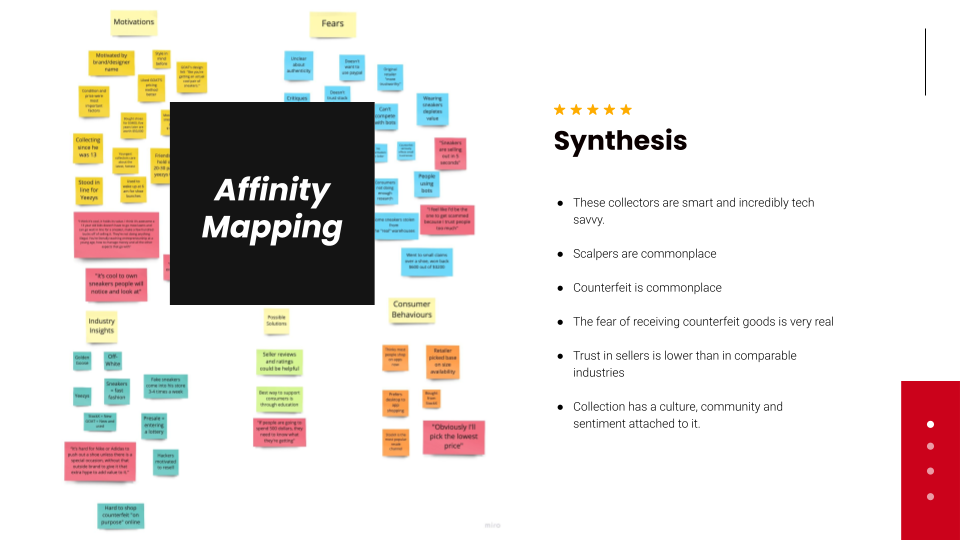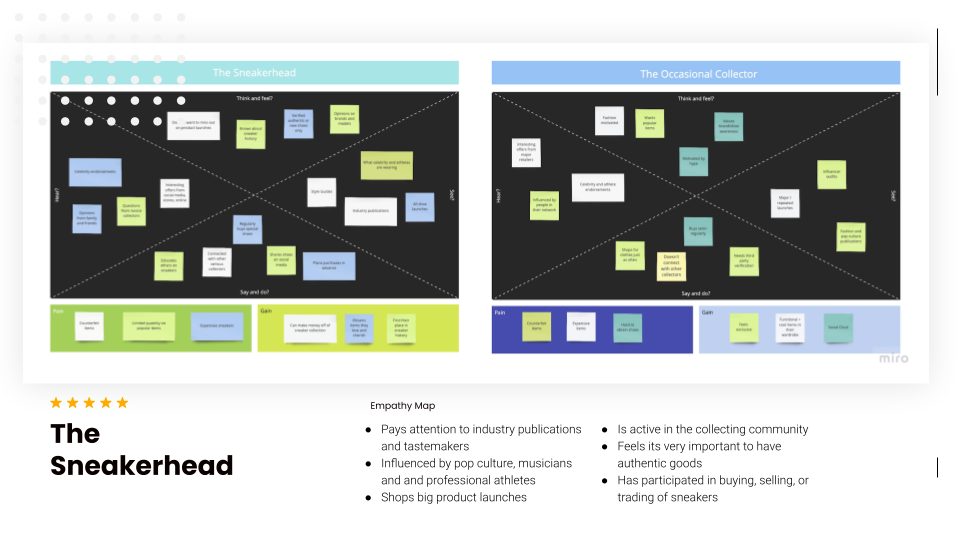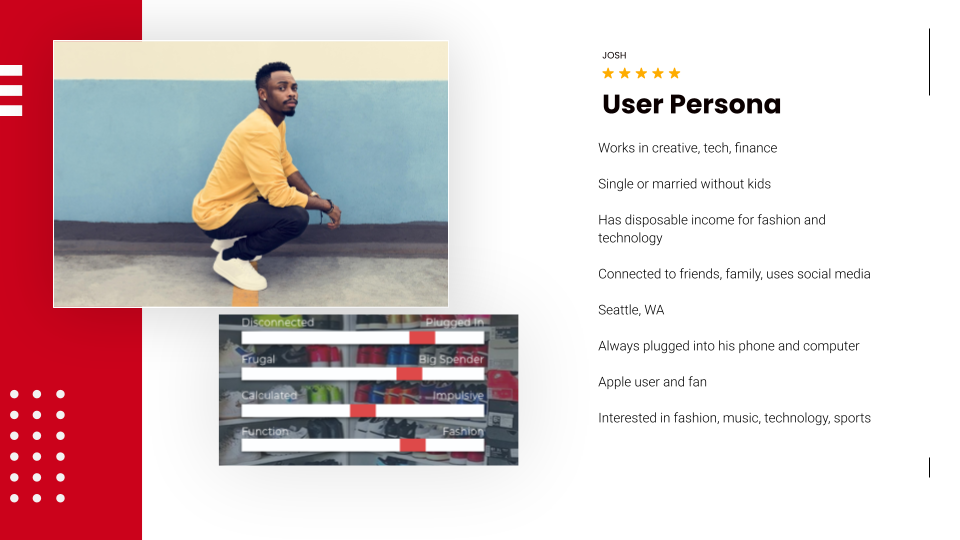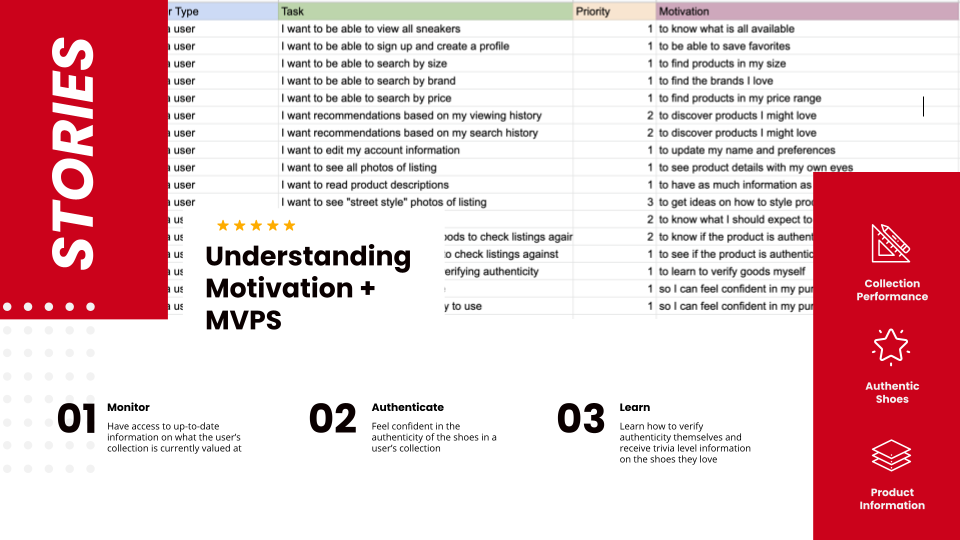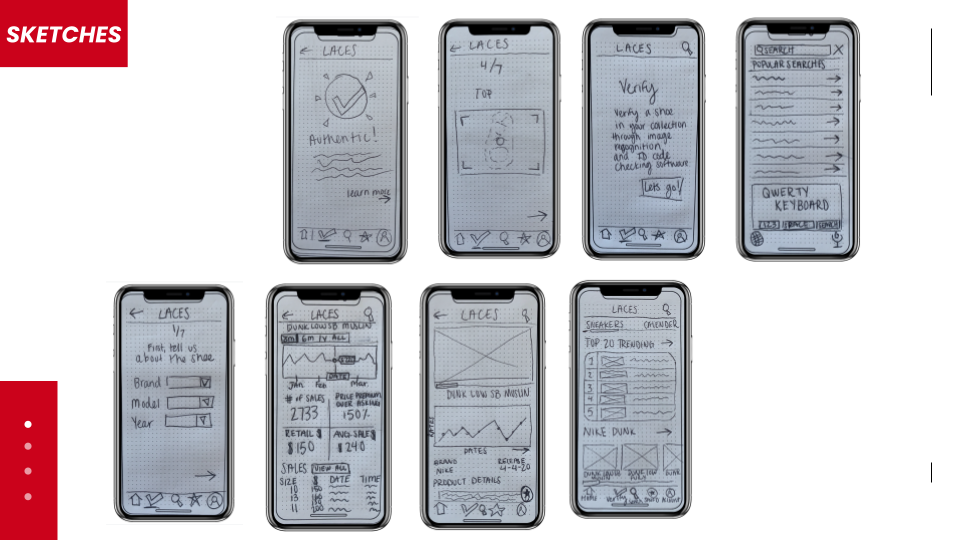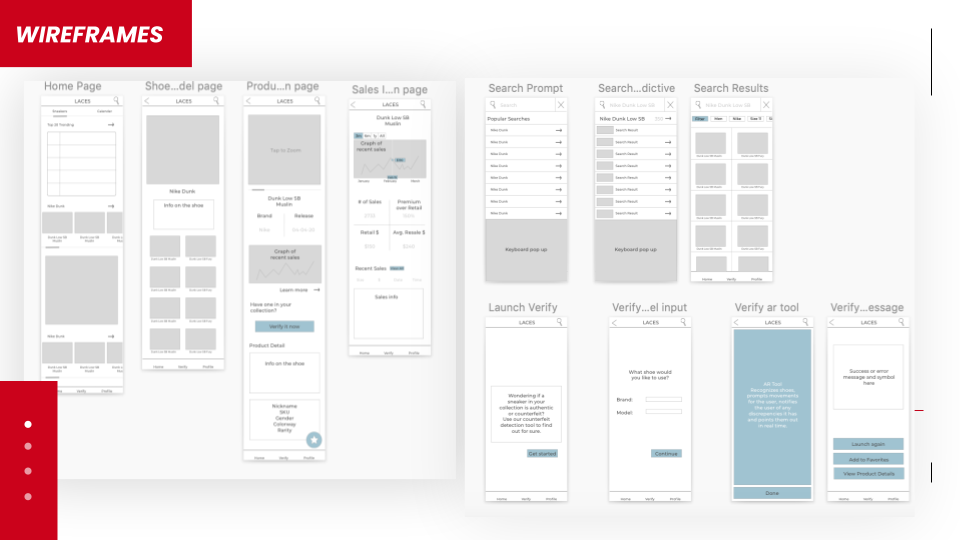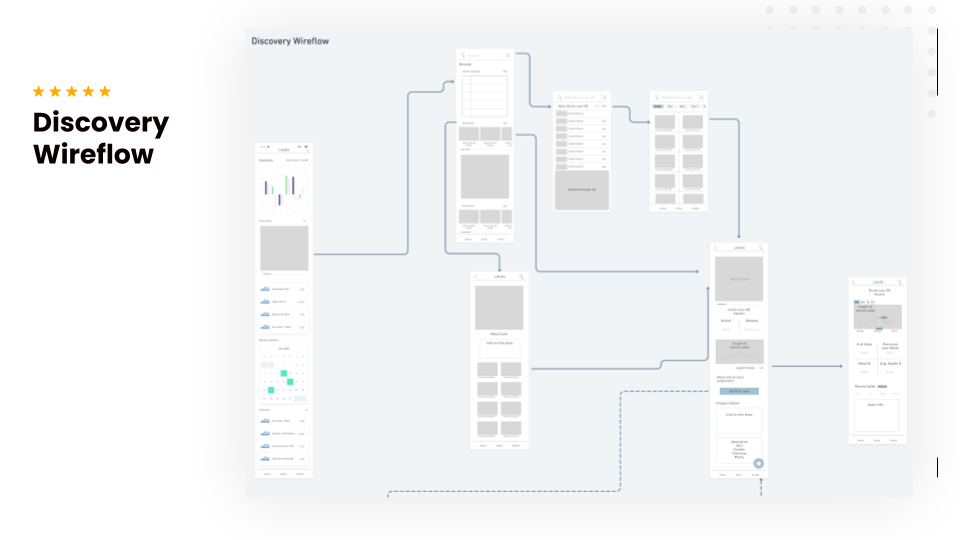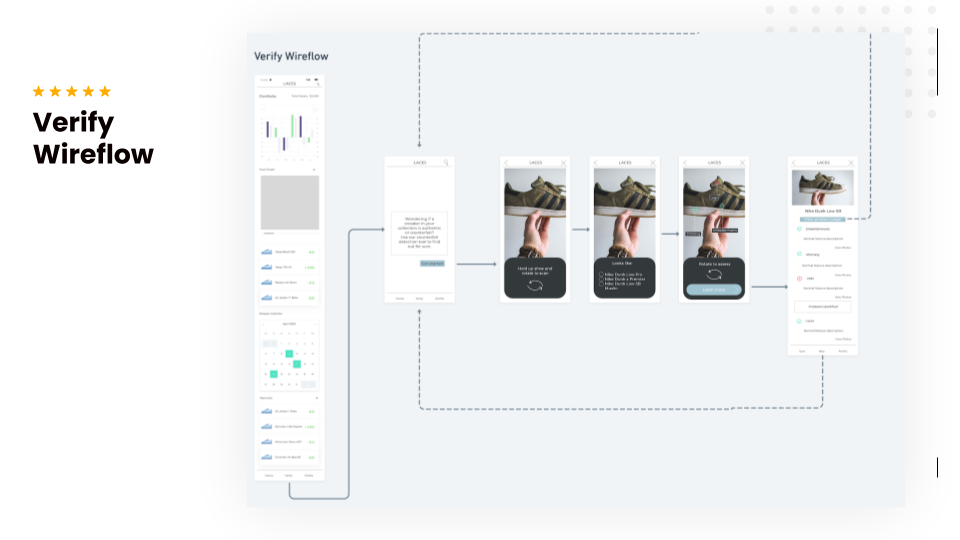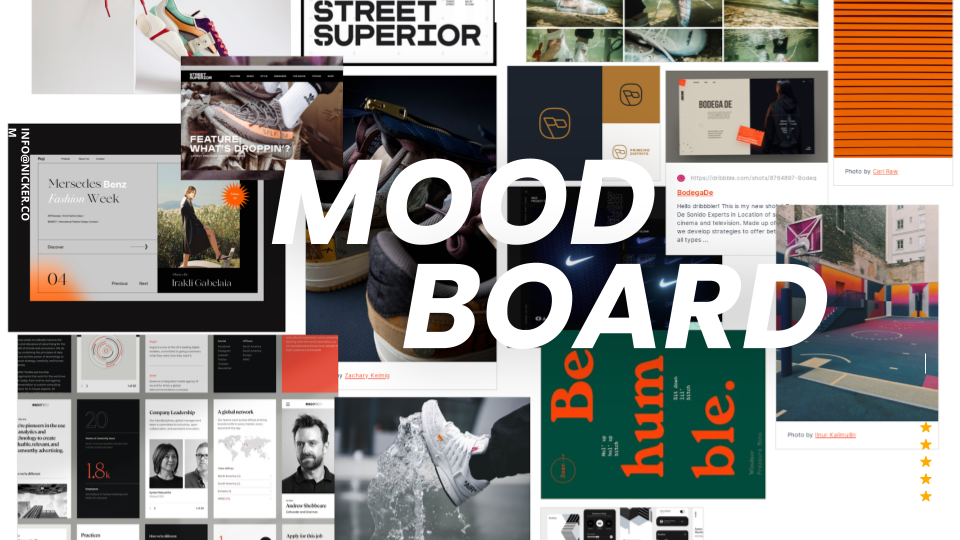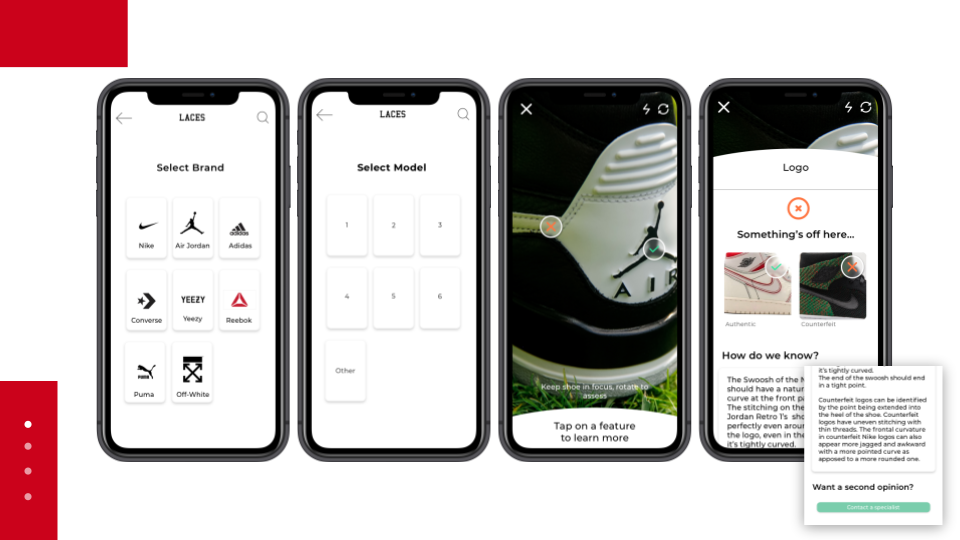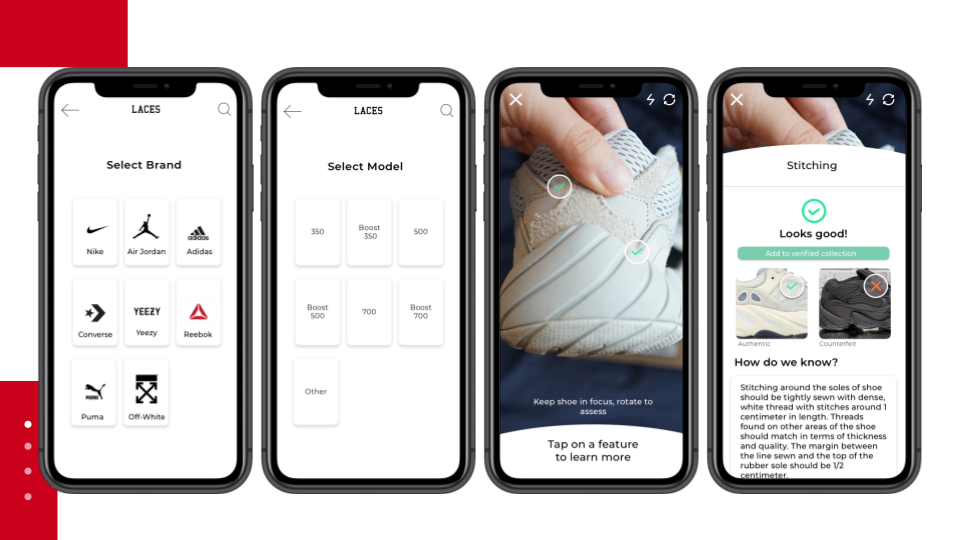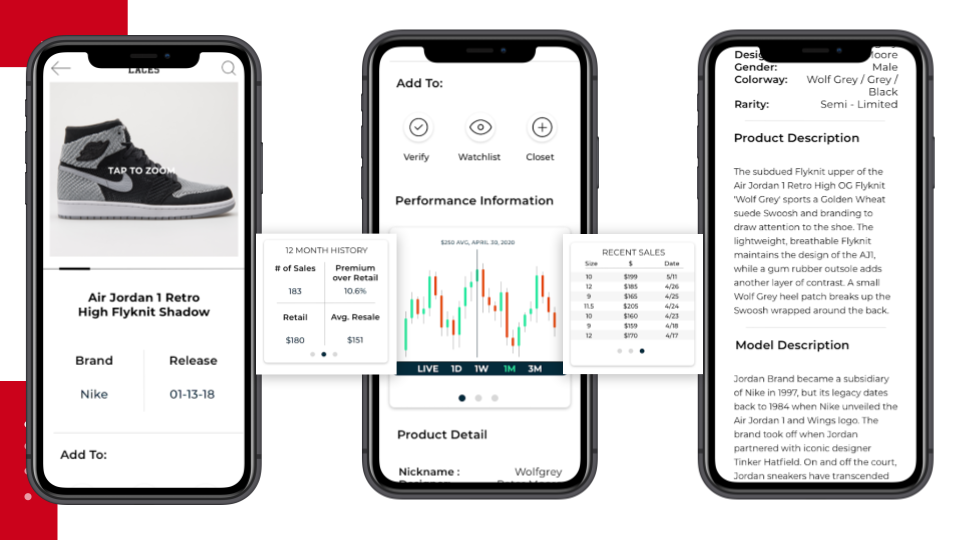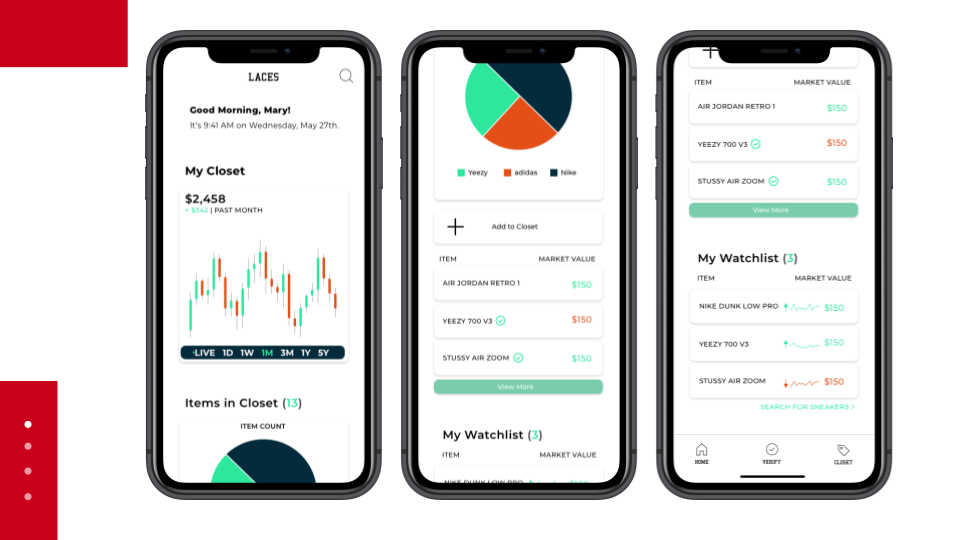LACES
helps sneaker collectors be the most successful buyers, sellers and traders they can be while providing trivia-level information and history on the shoes and brands that have shaped sneaker (and ultimately sports and music) culture.
Go to the prototype here

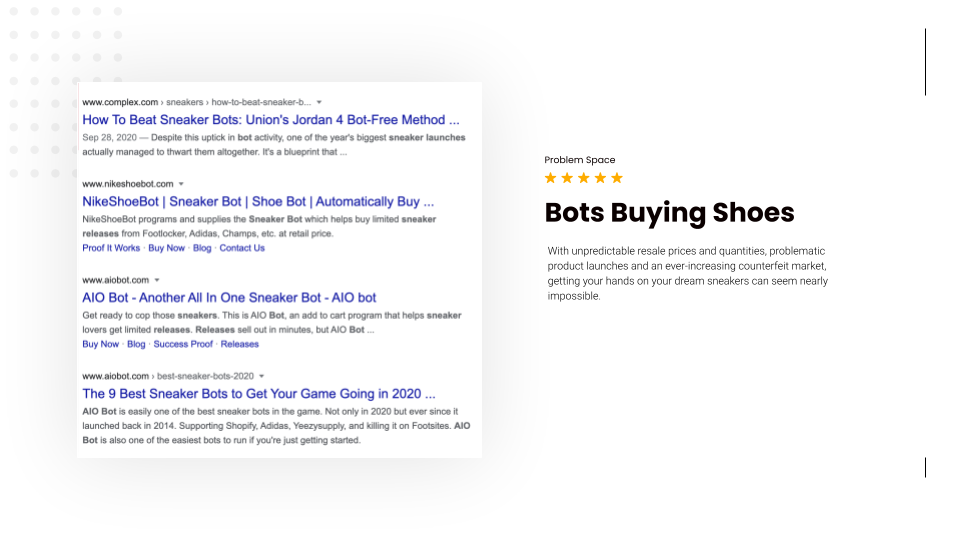

An App for Sneaker Collectors, really?
With unpredictable resale prices and quantities, problematic product launches and an ever-increasing counterfeit market, getting your hands on your dream sneakers can seem nearly impossible. In addition to hard-to-navigate, hard-to-negotiate sneaker resale stores and marketplaces, the modern sneaker collector has another huge roadblock standing between them and the products they seek: a huge influx of counterfeit shoes making their way into the hands and stores of people who don’t know any better.
Why is an app for sneaker collectors important?
I created LACES as a tool to help sneaker collectors identify authentic goods using artificial intelligence, educate consumers and also help shoppers navigate this niche industry filled with inflated and impossible to predict sales prices and bots fast tracking online check out procedures.
What did I do for this project?
I’m glad you asked! I was the lead on creating LACES and took this project through every step of the design thinking process from empathising with the user to testing the product. I conducted market research, user research, usability testing, and developed the experience and visual design of the LACES app.
About the App
LACES Key Features:
Monitor your sneaker collection like you would any other asset. Watch specific items, your collection as a whole and shoes you might have your eye on.
Authenticate shoes in real time.
Receive trivia level information on the shoes that mean the most to you and predict your best days to buy and sell.
How did you come up with this idea?
Initially, I wanted to create a better online, resale, shopping experience catered to sneaker collectors. As I did more research, the real pain points these users experienced has less to do with the actual finding, selecting, checking out processes of online retailing but rather with the planning of when to make a purchase and making sure the product’s they were looking at were authentic. I then toyed with the idea of creating an educational guide to help user’s verify sneaker authenticity themselves, but I wanted to push that idea further in order to have a truly special and unique user experience. So, I created a verification tool that not only analyizes a user’s sneaker for them, but also trains them on what to look for on their own.
Discovery
Okay, I’ll bite. Give me a little background knowledge...
To start, I needed to figure out all the problems that sneaker collectors face. I found my information from trade publications, shoe retailers themselves and talking with sneaker collectors about what their specific needs were. The biggest insights I got from my research was learning how important and how large the sneaker resale market is and discovering the problems associated with traditional sneaker retail, especially around highly anticipated product launches.
Sneaker Resale is a $1 billion USD industry
Counterfeit is a $461 billion USD (2016) industry, with shoes making up 22% of counterfeit items, the largest category
Sneaker resale is driven by limited quantities, the premium price they can go for, celebrity endorsement and nostalgia
Sneaker launches are “hacked”, making it extremely difficult for regular consumers to get their hands on a sneaker straight from the source online.
Competitive Edge
Although there was nothing exactly like LACES that I could find on the market, I gained a lot from looking at the biggest names in Sneaker Resale: GOAT, StockX, Grailed and Stadium Goods. Although I wasn’t creating an ecommerce platform, these apps gave me a lot of valuable insights into the industry and the zeitgeist of the sneaker culture.
Staying on Track
It was important for me to create a research plan to solidify my goals and set a schedule in which I would have my research done and could continue with the rest of the app. I wanted to identify strengths and weaknesses of current resale channels, identify users, and find solutions to streamline the online buying, selling and authenticating process of high-profile sneakers through conducting user surveys, user interviews, ongoing secondary research.
Survey
I sent out a screener survey to look at the amount of counterfeit shoes listed in online marketplaces, the effectiveness of apps when protecting consumers from fake goods, and what could be done to improve the online sneaker shopping experience. The surveys validated my hypothesis that consumers avoid resale sneakers due to fear of receiving a counterfeit item. This survey also helped me find and vet potential interview participants to further my research.
DEFINE
Talk to Me
When I felt familiar enough with the industry and felt like my screen surveys were successfully steering me in the right direction, I was ready to deep dive into some interviews with some sneakerheads themselves. I interviewed people with experience buying, selling and trading sneakers, most of them working in some part of the fashion industry themselves. I reached out to my network on social media and in alumni groups, as well as connecting with friends and acquaintances I knew had an affinity for shoes to send the survey to and from there, I selected 5 people I knew I wanted to learn more about. All interviews were conducted virtually due to the COVID virus.
Talking with my potential user’s themselves was one of the most important parts of this project for me because I could always refer back to things they said in their interviews whenever I felt lost. I wanted to keep their words, motivations and fears with me this entire process in order to create the best possible product for them.
I learned a TON more talking with real people about their shopping habits, what it is that makes sneaker culture so special and the role technology plays in their lives than I did from the rest of the discovery phase.
My main insights from conducting interviews were that buyers feel a lot of fear around buying sneakers at resale but are often forced into it to get the shoes that they love. They are motivated by being on the cutting edge of fashion and look to the athletes and musicians they love to guide their own sneaker purchases. Community is huge and sneaker collectors use technology to their advantage by connecting with others over social media and scouring marketplaces and resale stores alike for the best deals.
Interview Quotes
“I think it’s awesome 13 year old kids don’t have to mow lawns and can go wait in line for a sneaker and make a few hundred bucks off of it. They’re not doing anything illegal and you can teach entrepreneurship and how to manage money at a young age.”
“People get scammed on every platform.”
“Sneakers are selling out in 5 seconds.”
“Obviously I’ll pick the lowest price (when sneaker shopping).”
“If people are going to spend $500, they need to know what they’re getting.”
“Only the most popular, most expensive shoes get counterfeited”
Synthesise - Affinity Maps
To make sense of what I learned in my interviews, I used affinity maps to find patterns in my insights. I grouped key points from each interview into the following categories: Motivations, Fears, Industry Insights, Possible Solutions, and Consumer Behaviour.
What I learned about my interviewees:
These collectors are smart and incredibly tech savvy.
Scalpers are commonplace
Counterfeit is commonplace
The fear of receiving counterfeit goods is very real
Trust in sellers is lower than in comparable industries
Collection has a culture, community and sentiment attached to it.
Getting to Know my Users
Empathize with them
From my interviews and affinity map, I was able to create an empathy map to further get in touch with my potential user. I made two empathy maps: one for “The Occasional Collector” and one for “The Sneakerhead”. Both were helpful for me to empathize with, but going forward I decided to cater to the “The Sneakerhead” side, as I believed this would be the more challenging user to please and and if “The Sneakerhead” was satisfied with the experience and information presented in the app, then the less-serious user’s would be as well.
“The Sneakerhead”
Pays attention to industry publications and tastemakers
Influenced by pop culture, musicians and and professional athletes
Shops big product launches
Is active in the collecting community
Feels its very important to have authentic goods
Has participated in buying, selling, or trading of sneakers
Sneakerheads at a glance
Narrowing my focus on the “The Sneakerhead”, I got to work on my user persona. I kept him (Josh) at the center of the thinking throughout the whole process because out of the two users I chose for my empathy map, I thought “The Sneakerhead” would be the one that would be harder to please and I was ready for the challenge.
Important Information about Josh:
Works in creative, tech, finance
Single or married without kids
Has disposable income for fashion and technology
Connected to friends, family, uses social media
Seattle, WA
Always plugged into his phone and computer
Apple user and fan
Interests in fashion, music, technology, sports
What's the problem here?
After I had a solid understanding of who my users were and what their needs were, it was time for me to start defining what problem it was I was going to attempt to solve. I framed these problems facing sneaker collectors as questions to jumpstart my solution brainstorming.
How might we help consumers track sneaker value?
How might we help educate consumers on counterfeit products in the resale market?
How might we help consumers plan their sneaker buying and selling?
From here my mind started whirring, and my questions got more and more specific. how could users track shoes as they might with a financial app? How could I give users all the information they would need to make an informed purchase? How could we allow users to check if sneakers are legit or not and could we teach them how to do it themselves?
User Stories
I wanted to re-frame all the possible problems sneaker collectors face into stories to help me empathize with what the user’s motivations and end goals would be when using the app.
This allowed me to narrow the scope of the project and focus on what was most important to address for my users. I wrote what motivation a user might have behind any task and prioritized the tasks to begin developing my solutions.
Design
Map It Out
To better understand how user’s would navigate through Laces, I created an app site map. This helped me understand what the information architecture would look like in the app and helped me prioritize the information presented on each screen of the app. The map went through several iterations as the app was being developed and I ended up with a navigation that was as simple as possible.
Eventually for the third and final iteration, the map was minimized to just the home, verify and profile pages all along the bottom nav and put search in the upper right to reduce the cognitive load on the user and adhere to the consistency standards the user would be expecting from similar programs.
Sketch / Paper prototype
Sketching was a good way for me to brainstorm and try out ideas quickly and in a low risk way. Making the paper prototype allowed me to try different ideas and although the app changed a lot after this step, creating the prototype was a valuable experience because I learned what it was I wanted to change.
Guerilla Usability Test
I was able to do my first round of testing once having a simple prototype made. Although there wasn’t much detail, I could tell test the navigation and content I wanted to include in the app.
My biggest take-aways from testing were the following:
Build in sales information into the product information page
Add graph adjustments that are relative to the user’s interaction with the graph,
Improve symbols
build out the red routes of the product more fully.
Make the added value of the product clear at the beginning
I’m happy that there weren't huge issues with the usability or the layout, aside from the fact that a lot of the product had pages one had to imagine. I knew from here I needed to create an onboarding flow and think about my empty state design.
Wire Frames:
After my sketching and paper prototype and my first round of testing, LACES really started to take shape. I was able to apply what I learned from my testing and streamline the user flows in the app while thinking about the information architecture and visual hierarchy.
Wire Flows
Conducting wireflow’s allowed me to work through the app’s navigation and see if there were links between screens that were missing or needed adjustment. This let me assess if the app was easy to navigate and all flows were cohesive and the app felt like a single product.
What’s the look and feel?
https://app.milanote.com/1JorcN1gH52h7z
When I had the framework of the app down, I could then start to visualize how I wanted the design of the app to come across. Creating a moodboard helped me to affirm the influences that go into sneaker design in a visual way. I wanted Laces to reflect the musical and athletic influences that go into sneaker culture while remaining really clean, classic and accessible.
Style is Important
The logo font was inspired by sports typography, and I chose Montserrat for the rest of the in-app text because of it’s clean, minimal design and easy to read nature. I chose a neutral color palette with bright accent colors that reminded me of colors you would often find in athletic gear or sports arenas.
Prototype and Test
Finally it was time to put it all together into a prototype and put my product to the test.
https://maryrowles632419.invisionapp.com/console/share/YZ16NKHDJC/478412144
Usability Test Plan
I wanted to identify popular areas/features, identify common hindrances/usability problems in my red routes through my usability testing. Testing also served as exploratory research and I wanted my testing insights to provide solutions and opportunities for improvement to previously identified problems.
First Round of Tests
Testing was another hugely valuable step in the process it took to design LACES. Users for the most part found the app interesting and understood quickly what the app’s purpose was. User’s asked clarifying questions but were mostly correct in their assumptions when completing tasks. Users were able to complete all tasks with minimal help.
The most important finding from these tests was that after completing the verification task for a counterfeit shoe, the user is left to deal with their feelings of denial, defensiveness, or otherwise negative emotions upon discovering their likely really expensive sneaker is in fact, not authentic.
Another important finding was that the current design of the app relies heavily on color to display information. Several users asked clarifying questions about what colors meant and commented they could have used additional symbols to display information.
The app should have been built out more to provide a better user experience (further than red routes) as user’s often wanted to add a shoe to their closet, look at their closet, and would select features in the AI tool that wouldn’t lead them anywhere.
First Round of Iterations
Having learned a lot from my usability testing, I made the changes necessary, and prepared to test it again. Since there were no actionable items after finding a counterfeit shoe, I added next steps to help guide the user. I also combined two in app “collections” to create a singular closet with a verified authentic indicator. I added symbols and labels throughout the app to increase legibility and spaced out the design to give the user more “breathing room” when using the app.
Second Round of Testing
I knew we were getting close to having a finished product but I wanted to make sure the changes I made would make a difference.
I knew from my first round of testing that the user is left to deal with their feelings of denial, defensiveness, or otherwise negative emotions upon discovering a counterfeit shoe. Even after adding next steps, users still wanted more information, but generally liked the idea of speaking with a specialist. They also wanted to know what to do with their shoes and what sellers to avoid.
Another important finding was that several users were interested in having a social aspect to their shoe profile. Several users asked if there was a social element and would be interested in seeing others profile. To address this I would expand on search to incorporate a social element and allow users to see what is currently trending. User’s wanted to follow “big” sellers accounts.
Second Round of Iterations
So, I present to you, the final LACES prototype and its uses.
https://maryrowles632419.invisionapp.com/console/share/YZ16NKHDJC/478412144
Scenario 1
Josh wants to check if his Jordan Retro 1’s are legit. He uses the verify tool to scan the shoe and look for anomalies in the construction. Laces suspects something is wrong regarding the stitching, Josh can read up on why it was flagged and make an informed decision on what to do going forward.
Scenario 2
Josh wants to check if his Yeezys are legit. He uses the verify tool to scan the shoe and look for anomalies in the construction. Laces determines that the shoes look authentic and tells Josh why. He is informed on what makes this model authentic and can feel confident in his purchase or ownership.
Scenario 3
Thinking about either buying or selling a pair of Retro Jordan Ones, Josh goes to the product information page to see what the pair has recently sold for and what product information details should be included in the listing.
Scenario 4
Thinking about selling or trading something in his collection, Josh can quickly and easily check his collection’s value and how it has been performing on his home page.
Finishing Thoughts
Over the course of the project, LACES changed a LOT. LACES had humble beginnings, like really humble. Just check out some of my first sketches for the app.
One of my original ideas for the app was to have it be an educational guide on how to check counterfeit sneakers yourself. But I wanted to push myself to keep improving the experience of using the app. Providing guides and resources might allow the user to end up as the same conclusion that the AI might come up with, but where’s the fun in that? And who has the time? I wanted to streamline that process and make buying and collecting sneakers more accessible. I also had one point included an ecommerce element, but ended up taking it out to focus on the verification flow, asset management and product information.
Creating this project, I learned to be really flexible and to let the user guide you. If you keep them at the center of the product always, you can not fail. Going forward with this project, I would love to expand on the verification process. I would respond to the denial or defensiveness the user might feel upon finding out their shoe is illegitimate and provide them with options going forward. I would also love to create a social element to the app that could allow users to follow each other and see each other's collections. I would also include links to e-commerce sites to help my users find the best places to list their shoes and find the shoe’s on their watchlist. I had limited time working on this project, but if I were to pick it back up these are the kinds of things I would like to implement in this app.
Check out the finished prototype here!

